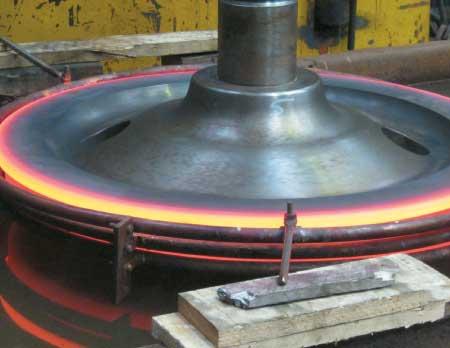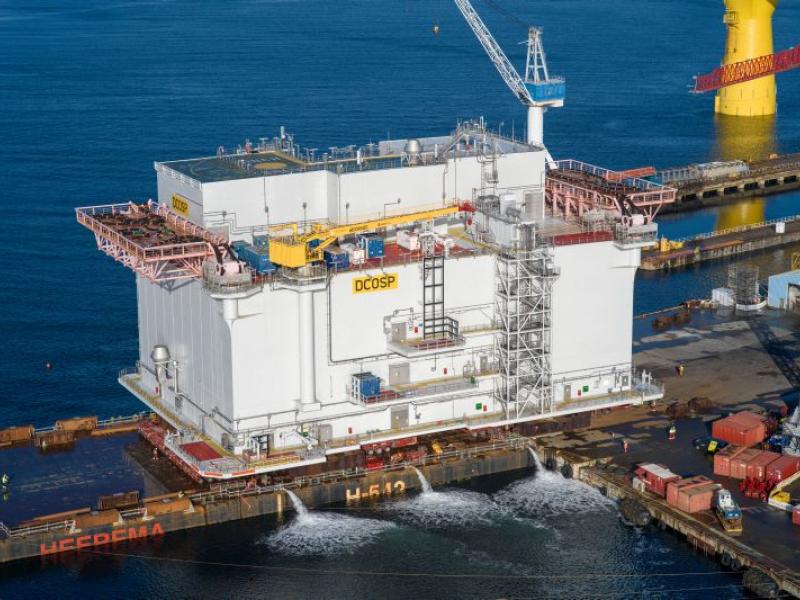|
Heat treatment is simply a function of ingredients, temperature, and time and therefore the outcome is pretty predictable.
But sometimes it’s just not that easy. Barry Robinson shares what happened when he was approached by MOTAT to rectify a minor problem with their new tram wheels.
Everyone seems to know that if you heat a piece of steel to “cherry red” and quench it in water it will come out hard. Fewer people know that it is dangerously useless in that state, and that it must then be tempered in order to make it usable. After quenching it is at its hardest and most brittle, but only after subsequent reheating for tempering will it be in its toughest state. Tempering does three very important things: It changes the brittle quenched microstructure to a tough tempered microstructure; it lowers the hardness; and tempering also importantly relieves the stresses caused by quenching.
Some engineers will know that all mainstream high-tensile bars and plates available in New Zealand are supplied in the already “hardened and tempered” condition. Steels such as 4140, 4340, P20, and Bisalloy 80 are all supplied hardened and tempered to around 26 to 34 Rockwell C. This is roughly equivalent to 800 – 1150 MPa breaking strength. Why is this important to know? Because if your steel merchant does not stock the size of high- tensile steel you need, you may get it cast at a foundry. And at that stage you absolutely must have the heat treatment conversation with the foundry. Somebody must remember. Failure to discuss heat treatment usually results in tears and lots of money being spent. Quite simply, unless properly heat treated the strength of these materials will not be the same as when purchased from the steel merchant.
A challenging assignment
But it’s not only high-tensile steels that can lead these unpleasant situations. Recently MOTAT (Museum of Transport and Technology) approached S.A.F.E Ltd to rectify a little problem with their new tram wheels. MOTAT had purchased 16 new tram wheels, cast in a medium carbon steel similar to good old 1040 (En8) medium-tensile steel. The wheels were supplied machined and press-fitted to the axles, all ready for fitting to the venerable old trams that shuttle visitors around MOTAT. But after some use it became apparent that the wheels were wearing out rapidly. A conversation with the supplying foundry revealed the wheels had not been heat treated to the required 32 Rockwell C hardness before machining and fitting. The heat treatment conversation had not
taken place.
The question was: How to harden and temper the wheels now? The heavy cast steel wheels, with a diameter of 730mm, had been precision machined and pressed onto the axles with a force of 50 tons. Even if the wheels were removed from the axle for full heat treatment, the slightest distortion during quenching would upset the precision press-fit. The only real option was to harden the outer rim using either flame heating or high-frequency induction heating. It is important to note that at this point there existed a great conflict in the project: The customer would like a really deep hardened layer. But these wheels are only held on the axle by compression-fit. If you heat to high temperature for a great depth the wheel will expand and remove itself from the axle very nicely indeed – in fact this is exactly what S.A.F.E do to gently remove shrink-fit, press-fit or seized items. Even if the wheel was restrained from falling off during heating, the heat could still stress-relieve the press-fit to an unknown extent – creating a possibly dangerous situation.
Finding a solution
It was clear that the heat input had to be hard and fast; S.A.F.E had to heat the outer layer as fast as they possibly could, and then quench before causing any problems with the press-fit to the axle, and all without melting the surface. S.A.F.E advised MOTAT that whilst their high-frequency induction heater was powerful enough at 250kW, the largest diameter previously processed was 410mm – significantly smaller than the tram wheels’ 730mm. It was doubtful they could achieve the required power density to simultaneously heat the entire wheel running surfaces (including the flange) to the minimum 850 degrees Celsius required for hardening without risk of the high heat migrating to the boss area. So the flame hardening option was then looked at in-depth.
Flame hardening would require a lot of high-energy burner nozzles and some serious array of high-flow regulators and pipework. Unfortunately it transpired that whilst the technology for full-rim heating possibly existed in Germany, the high cost and time requirements made it impossible for this to be an option for a one-off time-constrained project. A second “cop-out” flame option was to progressively heat around the rim with a single burner, quenching behind the burner as it travelled. But this option always leaves a soft spot at the start-stop point – and there is absolutely no way to avoid it. MOTAT quite rightly were not keen on their trams having wheels with a flat spot on the rim.
With time and options rapidly disappearing, S.A.F.E decided to give their 250kW high frequency induction heater a go, but with coolant spray nozzles specifically targeting the boss section to avoid it getting hot. No full size trial wheels were available, so testing had to happen on the job. A rough trial heating coil was made from copper pipe and fitted over the first wheel. Power was applied, and the heat results were promising. Several adjustments to the capacitor tapping were made, and eventually the results were promising enough to encourage S.A.F.E to make a close-fit coil that “hugged” the wheel contour. Further trials and capacitor adjustments, and finally the right combination of inductance, capacitance and frequency got the wheel rim hot enough to quench. Hardness testing on the rim gave 55 Rockwell C – an excellent result. But there were several more hurdles ahead.
|
The devil is in the detail
It was obvious during the trial heating that the wheel would have to be rotating within the close-fit heating coil in order to “smooth out” the hot and cold spots evident in the final trial. S.A.F.E had the rig to rotate the entire axle assembly, but the challenge now was how to have a close-fit high voltage coil held just clear of a rotating wheel just above the surface of a water tank, and able to be rapidly removed downwards into the tank an instant before the hot wheel was plunged into the same tank. To complicate matters the boss coolant spray rig plus a sub-surface bearing arrangement were also fitted just below the wheel. The final solution thankfully turned out to be wonderfully simple.
With the big hurdle of hardening the wheel rim successfully behind, the next even higher hurdle of tempering loomed. Tempering requires a much lower heat, but it must be precise, gentle, deep and long. Remember that the enemy on this particular job is a heat that is deep and long. The brutally efficient heating coil S.A.F.E created for the hardening was completely the wrong coil needed for tempering. A second coil was made specifically for tempering. Thermocouples were fitted to the rotating wheel rim to accurately monitor temperature while a very low power was applied to the heating coil. The rim was slowly brought up to 500 degrees Celsius and the power adjusted to hold it at this temperature long enough to allow for deep tempering and stress relief to occur in the entire outer “tyre”. Power was switched off, and the wheel cooled quickly to prevent the deep heat travelling to the boss. And finally the hardness was tested to measure the result of all previous efforts.
A new challenge lies ahead
At the start of this story it was explained that heat treatment is largely predictable, simply a function of ingredients, temperature, and time. But in this case the ingredients turned out to be the wild card, as the wheels had been cast in several melts with minor variations in chemistry, and no means of tracing any wheel to any given chemistry. This then caused unpredictable results. The default in this situation then becomes “trial and error” – but with no room for error.
The first half of the story ends well, with one tram being re-shod with eight new wheels with properly hardened and tempered rims, with the wheels still attached to the axles for good measure. The second half of the story has yet to happen. The second tram has worn its soft wheels down. All the induction hardening parameters have changed.
This story impressively illustrates the importance of talking heat treatment before manufacture – even if you do not know what you are talking about.
Barry Robinson is General Manager of S.A.F.E Ltd in Drury.
Email: Barry@SafeGroup.co.nz
|






